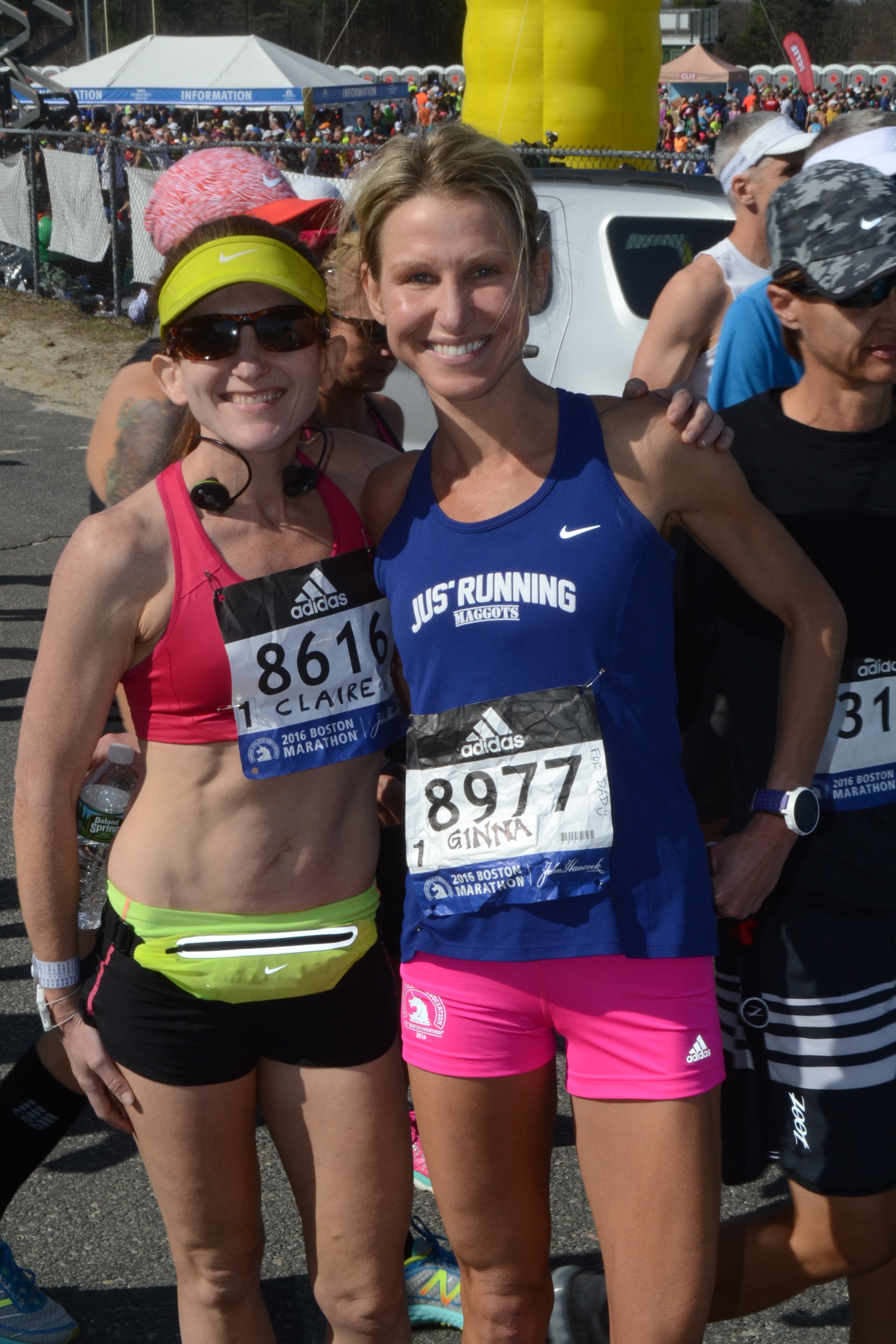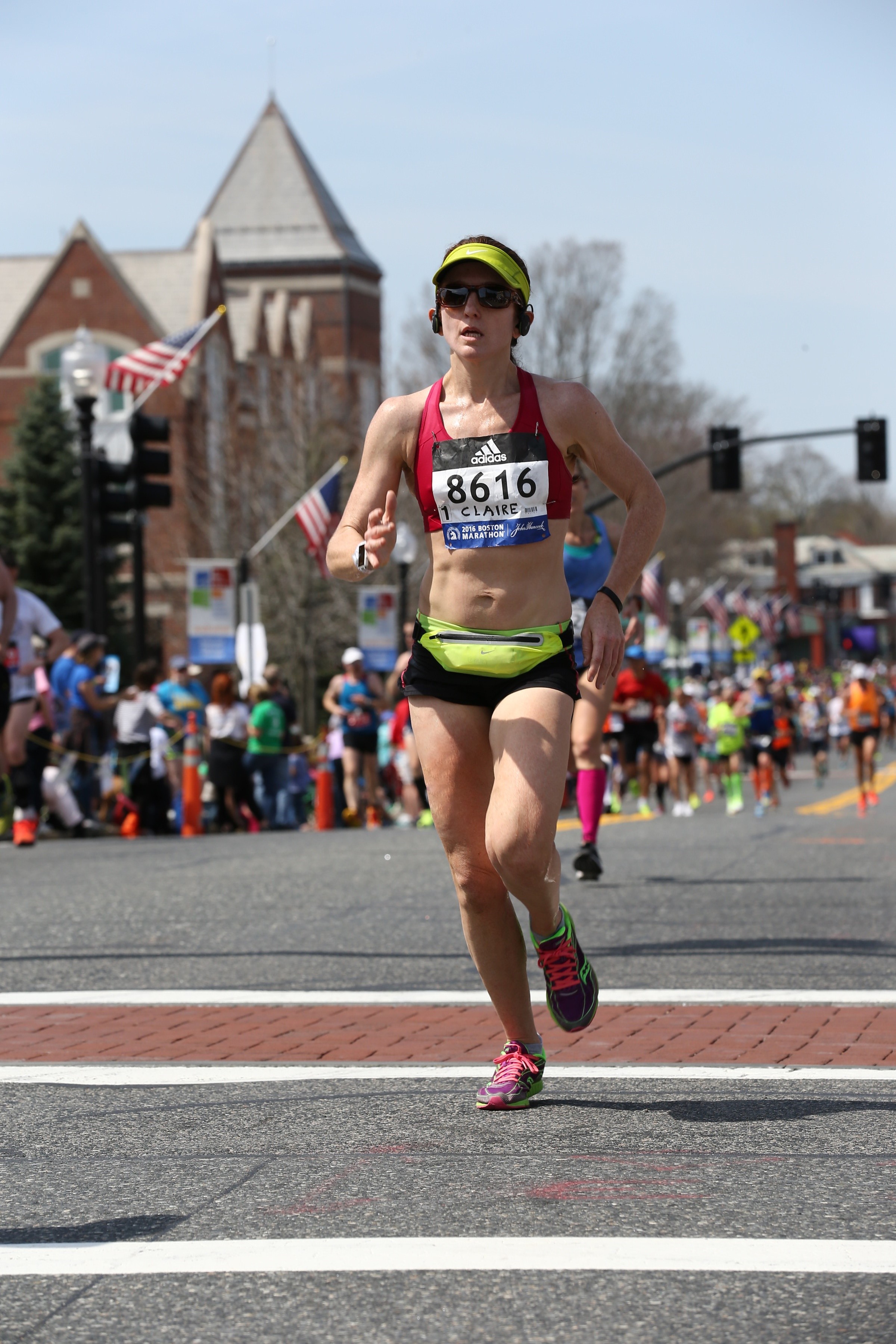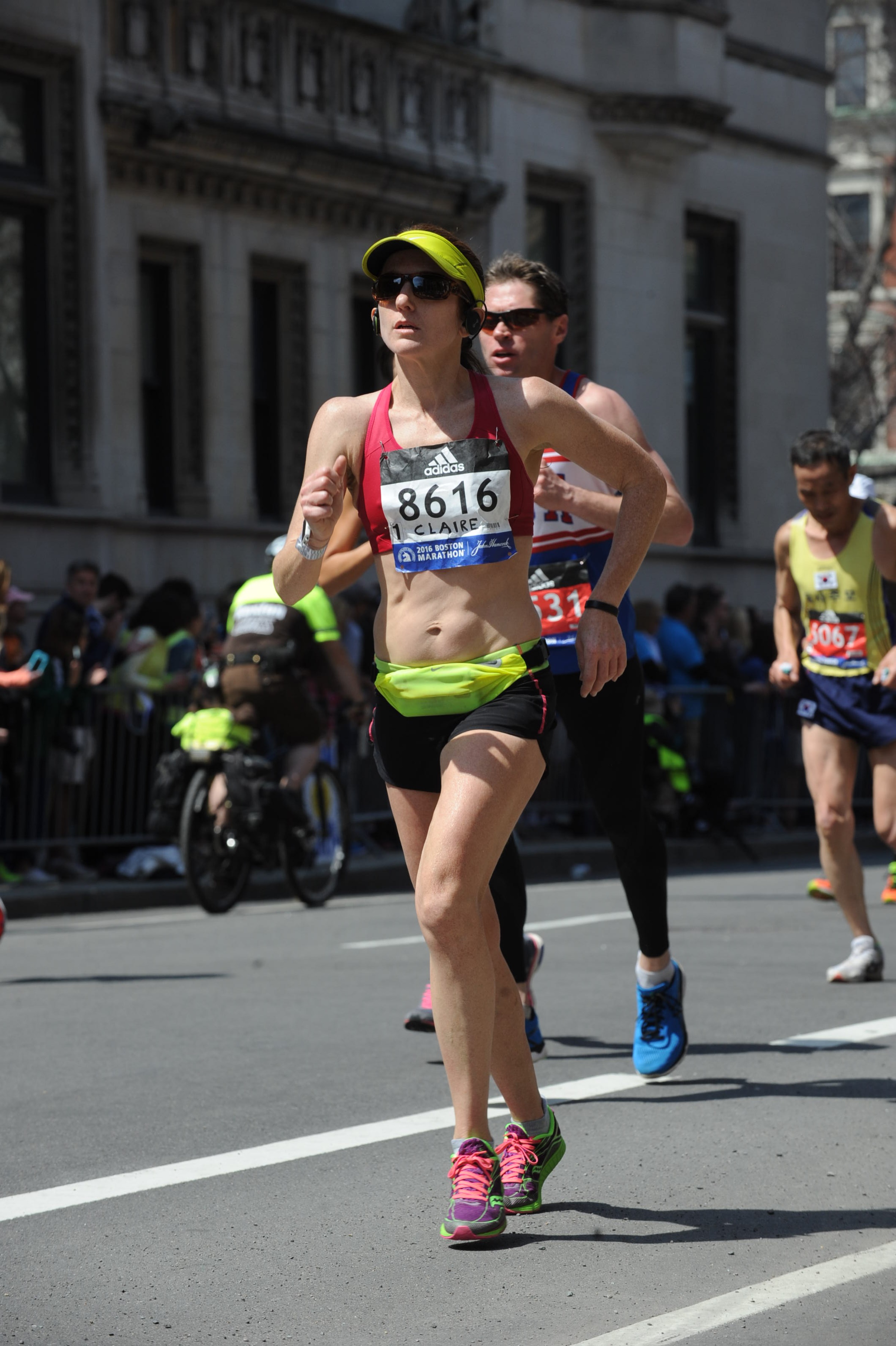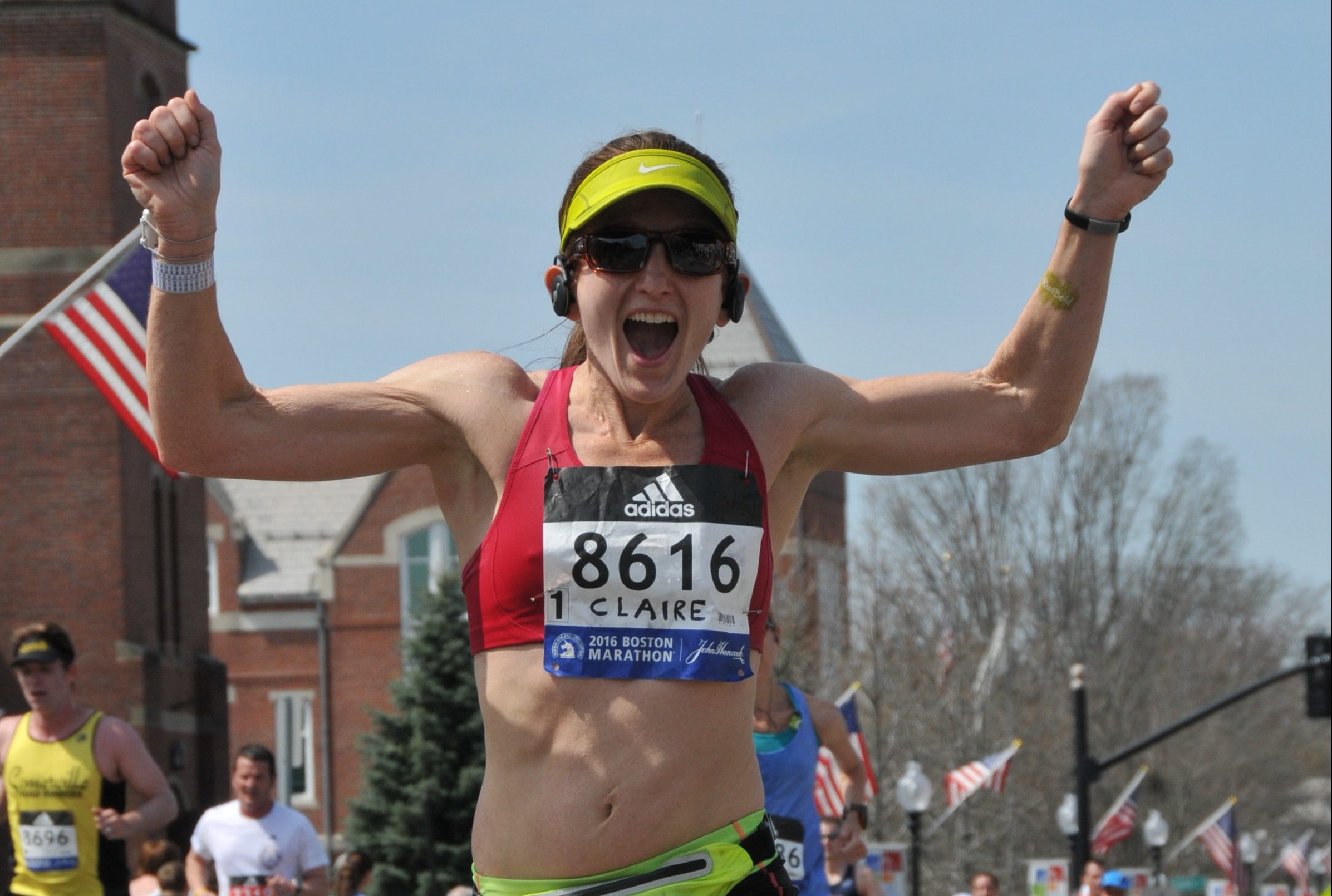When I ran the Boston Marathon for the first time in 2015, I figured it was a once-in-a-lifetime experience. I cried as I sprinted down Boylston Street and crossed the finish line with a 12-minute PR. Even though the weather was a miserable, rainy and windy 42 degrees, I felt on top of the world. Even harder than the 26.2 miles was the shivering half mile shuffle back to the hotel.
So why did I decide to go back again in 2016? Peer pressure. Many of my running friends from Asheville had newly qualified and I knew how much fun it would be to go with a group. And even better, some of my track friends had organized a drive to pay for Norman Blair, coach and owner of Jus’ Running, to come and spectate (you can read more about that here), so I felt compelled to go again. And I’m so glad I did, although it was a very different race.
After my 3:11:51 finish in the 2015 Chicago Marathon, my focus shifted to trying to crack 3 hours. I’m a big believer in big goals, even ones that seem just short of impossible. I also feel it’s important to set smaller goals so that you can still feel a sense of growth and accomplishment, even if the stars are not aligned for the big goal. Chopping 12 minutes off a marathon PR is pretty ambitious, but I had just made a near-15-minute leap from my 2015 Boston race, so 3 hours didn’t seem out of the question. I hired an online coach and got to work. Training was harder than I have ever done, but by the time I finished my last big workout, I knew I had a 3-hour marathon in me. What I didn’t know was if it would come out on race day.

Once we arrived in Athlete’s Village in Hopkinton, the sun was already out in full force. The old sweater I was wearing was quickly shed and the sunscreen was slathered on. The temperatures climbed into the upper 60s and would rise into the 70s during the race with a constant 10mph headwind. I lined up in Wave 2, Corral 1 with my friend and teammate Ginna and the gun went off.
Miles 1-3: 6:51, 6:45, 6:50
My goal for the first few miles of downhill was to stay right at goal pace of 6:52 and not faster. I did not want to alter my plan and start too slow, even in the hot conditions, because I needed to see if I could really do this. I have had a problem with racing too conservatively and ending up with more left in the tank at the finish line and I was determined to give this my all, no matter what. I had decided to run with music and Pandora promptly stopped streaming a quarter mile in. But Boston is a race where the fans are so amazingly supportive that no headphones were needed. I kept them in my ears anyway since that was the most comfortable place for them. Ginna, a much faster runner, had glided ahead of me at the start, but I never lost sight of her, so I took that as a good sign. By mile two, the first sign of the effects of the heat began to surface when I felt the beginnings of a stitch in my side. I had planned to take my first homemade gel at mile 3 and was planning to save my anti-cramp Fireball gel for much later on, but I knew better than to let the cramping get too intense. I sucked it down and almost instantly, the side stitch dissolved. I was naturally happy with that, but worried that I’d have nothing left if it happened again later. I quickly pushed that thought away and by mile three, I caught up to Ginna. I joked that she should “keep it in her pants” and then I inconceivably slipped ahead of her. I would not see her again until after the race.
Miles 4-8: 6:39, 6:59, 6:44, 6:47, 6:56
Coming off the major downhills, miles 5-10 even out as you go through the towns of Framingham and Natick. My plan here was to pick up the pace some and maybe throw in a few surges and then back off to save my energy. Obviously, mile 4 was way too fast and surely cost me in the second half. I corrected myself on mile 5, but then picked it up for the next two miles. The wind was a constant factor. I knew if I could tuck behind someone larger than me (not hard to do since I’m not that big), I could enjoy a windbreak. I attempted this a few times, but soon grew overly concerned with clipping someone’s heels so I would quickly slide back out into the open. Later, I would try it again and then start to worry about whether the person in front of me was even enough to keep my pace. It took too much mental energy to keep up the internal argument very long, so I abandoned that tactic and fully faced the wind. This is when I realized that starting in the first corral of a wave definitely has a disadvantage in the wind. Last year, it was just as windy, but I was solidly situated in a tight pack of runners that I hardly noticed it.

Miles 9-16: 7:00, 6:57, 6:59, 6:46, 6:54, 6:55, 6:55, 6:56, 6:46
I’m really proud of these miles. Even though they were slightly slower than goal pace, they were consistent and strong. I started getting into a rhythm. At the water stations each mile, I’d grab a Gatorade, swallow a couple sips, grab a cup of water, dump it on my head, then grab another water and gulp. The miles clicked by smoothly and I was surprised at how quickly each water station appeared in the distance. At the half way mark in Wellesley, I saw my time was just over 1:30. A negative split was out of the question with the Newton Hills ahead, but I still believed I had a good chance getting my B goal of 3:02. I know 3:02 seems like a strange goal, but at my first marathon in 2014, I got a 4:02 and thought it would be very cool to beat that by an hour.
Miles 17-21: 7:09, 7:12, 7:06, 7:48, 8:29
The Newton Hills. I expected to slow here as gravity took over and I was feeling strong through mile 19. As I took the hard right turn, I pumped my arms up and down to get the crowd into it. They were thrilled and roared at my effort. Then the cracks began to show. I remember last year being warned about how bad the hills were at this point in the race. As I ran up Heartbreak Hill at mile 21 in 2015 I asked a spectator if this was really Heartbreak since it hardly felt like an incline at all. This time, it felt like a mountain. I started to really struggle. I knew there were only two stoplights to go through to get to the top and I just kept repeating “two stoplights, two stoplights,” over and over again as I shuffled upwards. Many, many people were walking at this point. I had been pretty demoralized in Chicago to see people walking late in the race, so I tried to prepare myself for that this time. I blocked them out and just kept jogging as best as I could to get to the top, telling myself that I would find relief and could just cruise home. That was not exactly what happened.
Miles 22-26.2: 7:53, 8:07, 8:02, 8:07, 8:31, 8:15
It’s all downhill from here, right? This is the part of the course where you give it everything you’ve got and run as fast as you can. The race begins at the last 10K, they say. I crested the top of Heartbreak and told my legs to go and they refused. At some point during the hills I had looked at my watch and saw I was running in the 9-minute range and my will evaporated as quickly as the water I was pouring on my head . I don’t think I looked at my watch again. My favorite part of the race last year was Boston College, so I told myself to suck it up and run strong through the cheering crowds. I have no idea whether I did that or not. Mentally, I was turning to mush. I had gone through my last gel and decided to grab one of the caffeinated Clif gels on the course. I had tried one once before and couldn’t stand the toothpaste texture, but I felt I had to give anything a try at that point. I got one squeeze in and spit it out on contact. Gatorade would have to do. I greedily gulped down what I could every mile and each time felt it coming back up a half mile later. Once I finally saw the Citgo sign, I was scanning the sides of the road looking for places where I could throw up if I had to. I don’t think the idea of stopping ever really came into my head as it has many times before in races. I simply stopped caring about my speed and just knew I needed to get to the finish to make it all go away. With a little over a mile to go, I heard someone yell “Yeah, Jus’ Running!” I was not wearing my Jus’ Running singlet and I turned over my shoulder to see my teammate Andy, who had started 30 minutes ahead of me. My jaw dropped open and he just shook his head at me as he shuffled along. For a moment I thought about slowing down and running in with him, but I shook that idea off and kept going. I turned right on Hereford and pulled myself up the block before turning left for the home stretch on Boylston. Even though it’s only about 600 meters to the end at that point, the finish line looked about a mile away. Last year, I sprinted the last mile in an amazing (for me at the time) 6:38, positively bursting with joy and emotion. This year, just getting to the end without throwing up was the goal. My last mile was my slowest of the day, even slower than Heartbreak Hill. As hard as that was for me, I was shocked at the number of people that were walking down Boylston when we were so close to the end. Many much stronger runners suffered worse than I did. I crossed the finish, clicked my watch, and saw I had at least gotten a PR by just 25 seconds at 3:11:26. A PR was my D goal.

Afterwards, I slowly made my way through the finishing chute hoping to find Ginna right behind me. Another teammate, Danielle, who had started in the corral behind us came through next. We chatted about the race and several minutes later Ginna had caught up with us. It turned out that at mile 4, Ginna lost some of her hearing in one ear. She compared it to the feeling you get when driving up to altitude, but she could never equalize the pressure. She debated going to a medical tent and ultimately decided just to keep going. She knew it was not going to be her day. At mile 18, a spectator handed her a beer and she gladly took it. Ginna, a 1:25 half marathoner, finished in a disappointing 3:18. A couple hours later, her ears cleared and several other runners told her they had experienced similar ear pressure problems on runs before.
It’s a strange feeling to run your best pace, but yet not your best race. I really felt like I had a great shot at my goal until mile 19 when I fell off a cliff. What I am proud of is that I gave it everything I had. There was nothing left in the end and I know that I took the risk I wanted to take and in some ways, it paid off. Not in the way I was hoping, of course, but I know that if I had started off more conservatively and finished stronger, I would have always wondered if I could have given more. I began the race as a 3:11 marathoner and I still am. But I know that I still have a long way to go.

